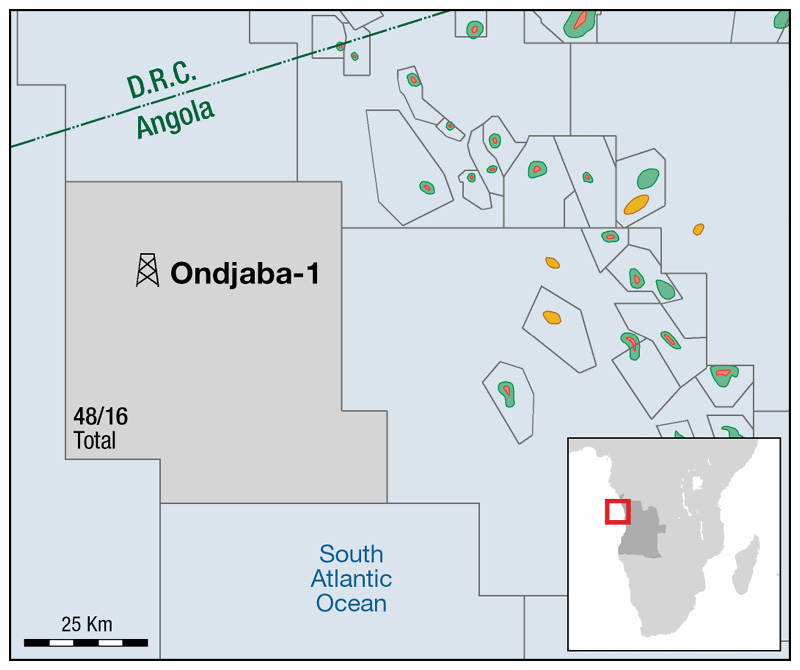 Map showing location of the Ondjaba-1 well, offshore Angola.Total Energies have drilled the Ondjaba-1 wildcat offshore Block 48, Angola. Along with Maersk, and this time using the Maersk Voyager, they beat their previous record (offshore Uruguay at 3,400m water depth), spudding in 3,628m water depth. The Lower Congo Basin at this distal position has two potential play types: late rift phase carbonate mounds, and drift phase deepwater turbiditic sands. The nearest well, Manjericao-1, is located some 30 km to the east and is a suspended drift phase oil discovery. The pre-salt section is not well imaged on seismic, but basement horsts and tilted fault blocks may be present over which late rift phase carbonate mounds could have been emplaced in shallower waters. Primary carbonate porosity may have been enhanced through dolomitisation if subaerial exposure occurred. These reservoirs would be equivalent to those of the giant Tupi field (on the conjugate margin, offshore Brazil), and to similar discoveries made in the Kwanza Basin of Angola (Blocks 21 and 23, Cameia and Bicuar). Drift phase reservoirs targets may include Upper Cretaceous, Paleogene and Neogene channel / fan turbidite complexes, and it is not clear yet of these are being targeted post-salt, or indeed if the well is west of the Aptian salt distribution. Total Energies and partners Qatar Energy estimated a target volume of 823 MMbo, with a chance of success of 20% and a dry hole cost of US$46 million. The Maersk Voyager appeared to move off prospect without testing. The national authority in Angola, ANPG, recently announced a bid round of eight offshore blocks including Block 32 to the east, so the industry will be focused on the timing of the well results and the bid round deadline.
Map showing location of the Ondjaba-1 well, offshore Angola.Total Energies have drilled the Ondjaba-1 wildcat offshore Block 48, Angola. Along with Maersk, and this time using the Maersk Voyager, they beat their previous record (offshore Uruguay at 3,400m water depth), spudding in 3,628m water depth. The Lower Congo Basin at this distal position has two potential play types: late rift phase carbonate mounds, and drift phase deepwater turbiditic sands. The nearest well, Manjericao-1, is located some 30 km to the east and is a suspended drift phase oil discovery. The pre-salt section is not well imaged on seismic, but basement horsts and tilted fault blocks may be present over which late rift phase carbonate mounds could have been emplaced in shallower waters. Primary carbonate porosity may have been enhanced through dolomitisation if subaerial exposure occurred. These reservoirs would be equivalent to those of the giant Tupi field (on the conjugate margin, offshore Brazil), and to similar discoveries made in the Kwanza Basin of Angola (Blocks 21 and 23, Cameia and Bicuar). Drift phase reservoirs targets may include Upper Cretaceous, Paleogene and Neogene channel / fan turbidite complexes, and it is not clear yet of these are being targeted post-salt, or indeed if the well is west of the Aptian salt distribution. Total Energies and partners Qatar Energy estimated a target volume of 823 MMbo, with a chance of success of 20% and a dry hole cost of US$46 million. The Maersk Voyager appeared to move off prospect without testing. The national authority in Angola, ANPG, recently announced a bid round of eight offshore blocks including Block 32 to the east, so the industry will be focused on the timing of the well results and the bid round deadline.
Ondjaba-1: Total Energies Explore New Depths
Total Energies, with operating partners Qatar Energies and Sonangol, have drilled the Ondjaba-1 wildcat offshore Block 48, Angola.





